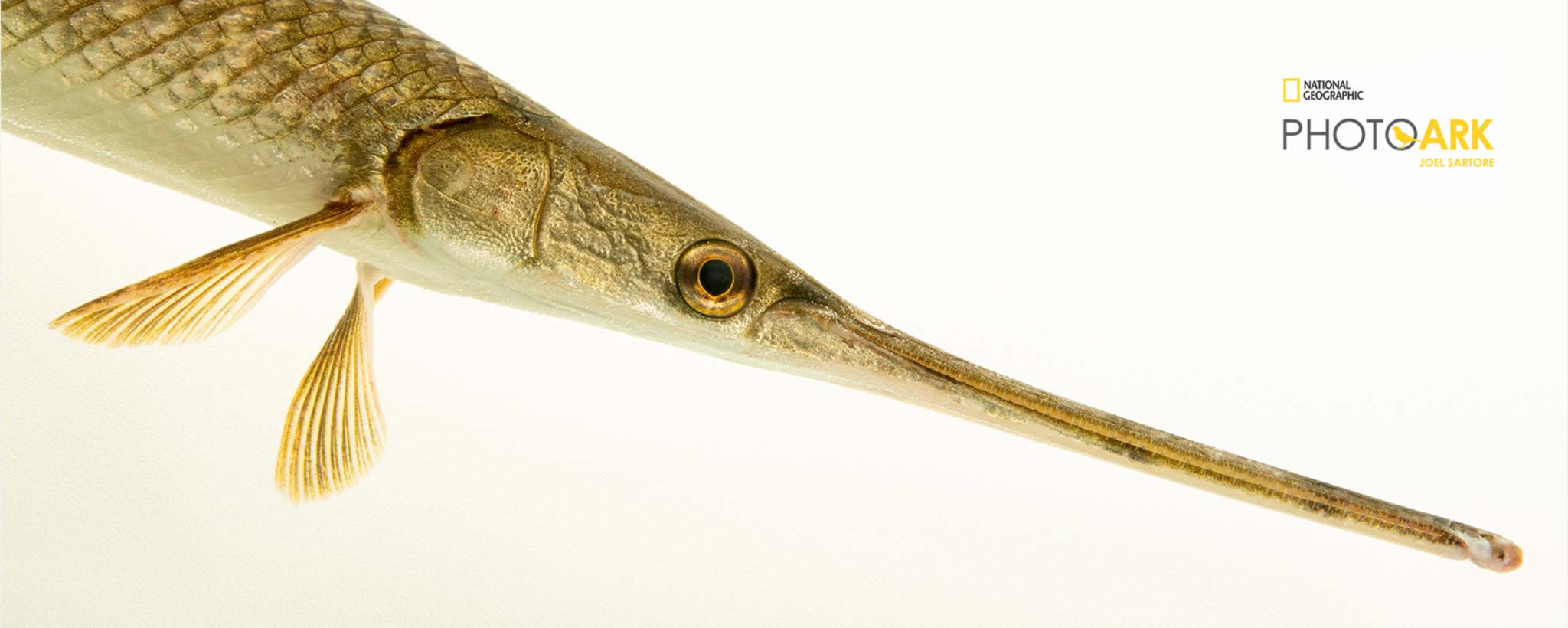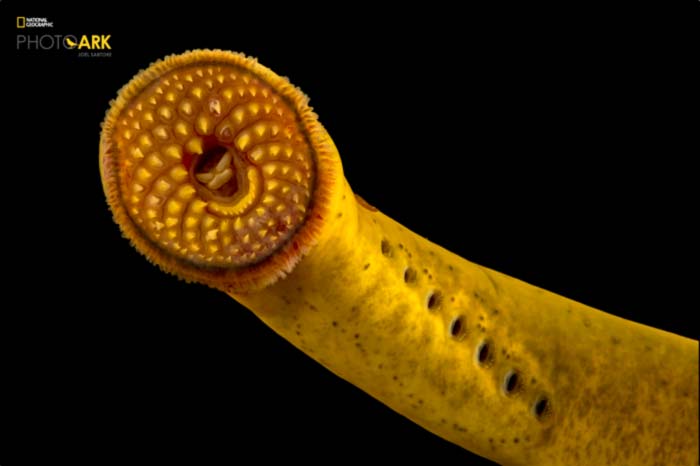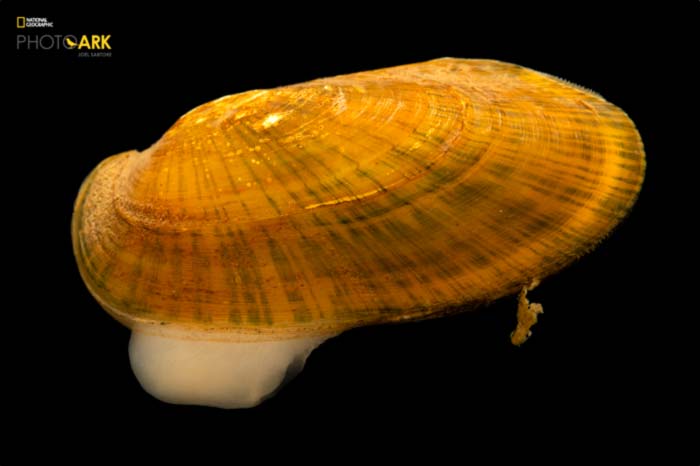Articles

Now You See 'Em
With a little help from TVA scientists, a noted National Geographic explorer swings by the Tennessee Valley to photograph endangered aquatic life as part of a worldwide collection of rare species.
MAY 18, 2021 — Joel Sartore is an American photographer and author who uses studio lighting and simple black or white backgrounds to capture the personality of the world’s animals. His technique is simple, yet makes his images of a St. Andrew beach mouse look as grand as an Asian elephant, and a tiger-striped tree frog appear as massive as the litter of coyote puppies that Oscar-winning documentary filmmaker, Louie Psihoyos, projected on the side of the Vatican, the Empire State Building and the United Nations building six years ago.
Sartore’s work is dedicated to an archive of animal portraits called the Photo Ark. The National Geographic project is his personal odyssey to photograph the estimated 20,000 species living under human care in locations around the world. The effort has taken him to all seven continents and across at least 60 countries.

Lamprey ©Photo by Joel Sartore/National Geographic Photo Ark. NatGeoPhotoArk.org
Today, his archive holds a boatload of species totaling more than 11,450. He snapped the first Photo Ark portrait inside a Nebraska zoo in 2005. His goal is to do in 25 years what took the biblical Noah 120.
“My job is to get people to care,” Sartore said. “But first, we have to let people know there is a problem.”
According to a 2019 United Nations report, species are declining at rates unprecedented in human history. More than one million plants and animas are now threatened with extinction. Since 1900, the planet has lost 500 species of animals.
Sartore photographed the last of at least six of them, including a small catfish that was geographically restricted to the Nolichucky River watershed in Greene County, Tennessee. The chucky madtom was last seen alive in 2004.
Photo Ark Docks in Tennessee
Any photojournalist who wants to track down rare species must rely on a global community of specialists who know enough about specific categories of animals to identify them by their Latin names. Tennessee Valley Authority biologists Jon Michael Mollish and Todd Amacker are part of Sartore’s army of breathing encyclopedias who help locate and name Photo Ark specimens.
Their knowledge took Sartore to the small town of Maryville, Tennessee, where the Little River — one of the world’s most biodiverse temperate streams — flows along its 60-mile-long journey from the Smoky Mountains National Park to the Tennessee River. Aided by May’s warmer temperatures, Sartore captured studio-style portraits of some two dozen aquatic animals in full-breeding plumage.
Subjects included darters, minnows, freshwater mussels and a surprise lamprey.
“I go to places where biologists say they can get me great species, and indeed they have,” Sartore said. “It’s just really amazing what comes out of the stream here.”
Although the Little River is what biologists call a “biodiversity hotspot,” the abundance of aquatic life extends far beyond its banks and throughout the Southeast. In fact, the Tennessee Valley alone is home to more than 350 species of fish.
Sartore says that’s more than are in all of Western Europe.
“It’s not all about giraffes and elephants and tigers,” he said. “The little things are what really run the world and keep us all healthy.”
Water vs. Resources
Sartore’s calling goes beyond his ability to read a light meter and create breathtaking art for the enjoyment of others. He’s a former newspaper photographer who’s spent a lifetime telling stories with pictures that warn, evoke emotion and spark action.
Actor Harrison Ford, who is the vice chair of Conservation International, says Sartore’s art is vital because the world is losing lifeforms faster than any time since the disappearance of the dinosaurs.
In the foreword of Sartore’s first book, “The Photo Ark,” Ford wrote, “The importance of work like Joel’s is that it reminds us to care. His subjects look us in the eye. They challenge us…. They make us laugh and sigh and wonder.”
Sartore doesn’t have to wonder. He knows what the science suggests, and that urgency is what drives his 60- and 80-hour weeks as he races around the world to show people the creatures they never knew existed.
“By the end of the century, we could lose half the species on Earth,” Sartore said. “We all need this stuff. We can’t lose half of everything and expect the world as we know it to stay the same.”
The warning stems from a basic calculation between available resources and the amount of water required to sustain both the world’s biodiversity and its growing global population.
In 1973, there were 212 million people living in the United States. Today, that number is about 330 million and is projected to nearly double by 2100, according to the U.S. Census Bureau. The United Nations Population Division reports that the current global population sits at 7.8 billion and is forecasted to reach 11 billion by 2100.
In addition, the U.S. Forest Service projects many regions throughout the United States will see water supplies reduced by a third from today’s levels within the next 50 years. Irrigated agriculture, now totaling 75 percent of annual consumption, is expected to cause shortages across 96 of the nation’s 204 freshwater basins. As a whole, the U.S. is slated to experience more than a 30 percent decline in current precipitation levels by 2080.
The Tennessee Valley and West Coast regions of Washington and Oregon are expected to be the greatest affected, losing about a foot of annual rainfall by 2040. National Geographic points to rising temperatures and evaporation as the root cause, and predicts the U.S. could be as much as 5.7 degrees warmer by 2050.
The Forest Service report suggests the combination of scarce water and rising population pose a threat to both the nation’s water and food security.
“My job is to get people to care about what is happening to the environment while there is still time to save most of the other species and ourselves in the process,” Sartore said. “The problem is that there are so many of us, with so many hungry appetites, that we seem to be deforesting the planet as fast as we can and basically eating ourselves out of house and home.”
Big Lessons in the Little River
Preserving the world’s animal and plant species comes with some unique benefits. The Pacific yew, for example, is a North American conifer that produces a chemical called Taxol, which effectively treats breast, ovarian and lung cancers. There’s also a shrub in Madagascar, called the rosy periwinkle, that can put leukemia and Hodgkin’s lymphoma into remission.
The Little River doesn’t hold a known cure for cancer. Instead, it preserves life by maintaining the water quality required to sustain its 80 species of fishes, 10 species of crayfishes and 18 different varieties of freshwater mussels that live within its waters.

Cumberland Moccassinshell ©Photo by Joel Sartore/National Geographic Photo Ark. NatGeoPhotoArk.org
“When we save species like mussels, we’re saving ourselves,” Sartore said. “They’re living water monitors.”
“They’re kind of like our aquatic canaries in a coalmine,” he added, referencing the sacrificial use of birds to detect fatal amounts of carbon monoxide deposits inside underground mineshafts and tunnels.
According to Amacker, who is TVA’s freshwater mussel expert, Sartore’s synopsis is accurate. Freshwater mussels serve as natural water filters by removing suspended algae and bacteria that is potentially harmful to humans. They filter chemical compounds, which is essentially a biological safeguard against environmental compliance violations like toxic pesticide runoff, oil sheens and illegal manufacturing dumps.
Mussels also help shape the physical features of a stream by serving as nature’s riprap. They reduce the probability of severe erosion by stabilizing the streambed, which helps prevent muddying the aquatic ecosystem with the world’s most common river-killing pollutant — sediment.
TVA monitors Tennessee Valley waterways for dirt and other pollutants through a system called the Index of Biotic Integrity. The IBI is a sampling methodology TVA developed in the 1980s to assess stream health by annually surveying fish and aquatic communities. The index allows the agency to identify and track water-quality issues throughout its seven-state service region.
Mollish is one of the biologists who conducts the ongoing IBI assessments. He is a minnow and darter expert who tracks the movements of these small fishes throughout the Tennessee River watershed. He says each of the fishes’ migratory patterns provide him with datasets that protect the drinking-water source of more than 5 million people.
“If I survey an area and notice fish-X is missing but fish-Y is there in higher numbers, it may point me to a particular type of pollution,” Mollish said. “By preserving these little minnows and darters, we are preserving a crystal ball for future generations. These fishes raise the flag and give us the time and the foresight to hopefully correct water-quality problems before they ever have a chance to become a human health concern.”
As part of TVA’s ongoing stream-health monitoring, TVA’s biologists collect and preserve fish samples that serve as time capsules for future research. Currently, a 50-year-old trove of TVA’s pickled darters, minnows and black bass, are helping the University of Tennessee conduct the world’s first comprehensive freshwater microplastics pollution study. UT expects to release its findings this fall.
Conservation Economics
Preserving the purity of the entire 40,890-square-mile Tennessee River watershed is an ever-present challenge that protects the Little River’s federally listed sickle darter, marbled darter, snail darter and its four threatened species of freshwater mussels. Apart from the public health necessity to preserve these animals’ survival, crayfish offer the public a few billion more reasons to keep the streams clean.
According to a 2017 TVA/UT study, the Tennessee River watershed fuels a recreation industry that supports 130,000 jobs and attracts an estimated $11.9 billion in annual revenue. But without crayfish, the hook to one of the Southeast’s largest tourist attractions would be bare.
The economics hatch from biology.
Crayfish are directly responsible for 90 percent of a smallmouth bass’ diet. This fact suggests the pinching food source is the reason that three Tennessee River reservoirs — Guntersville, Pickwick and Chickamauga — are ranked among Bassmaster Magazine’s “Top 25 Best Bass Lakes of the Decade.”
“Think about how many bass baits are designed to mimic crayfish,” said TVA Zoologist Jeff Simmons. “Could you imagine fishing a river or reservoir without crayfish? Even if you found one, the bass population wouldn’t be very healthy, and the fish you did catch would be small.”
It’s no secret. Small smallmouth and largemouth bass are not exactly an angler’s dream. Big fish are the big-money draw for both spectators and enthusiasts, and the Visit Knoxville Sports Commission has proof.
In 2019, crayfish paid a $32.2 million dividend to the East Tennessee city when it attracted 153,809 people to the Bassmaster Classic’s three-day professional fishing completion. The winning 15-fish stringer weighed more than 49 pounds and earned Ott DeFoe a $300,000 prize.
A Shared Mission
Sartore knows both the economic and environmental stakes of not protecting the world’s species, but he says his job is not to tell people what to think. He only wants to create art that might make them stop long enough to think.
“We humans are primates and we’re all about eye contact,” Sartore said. “If you’re really interested in someone, you look them right in the eye. I figured if I could do the same with animals, it would engage people more and they would make more of a connection.”
Even though completing the Photo Ark will take another decade of his life to complete, Sartore is not waiting to introduce people to all the creatures that are living in the world around them. He’s published four Photo Ark collections, and is releasing his fifth on Oct. 19. He hopes his dramatic portraits of animals, whether seen in his online archive or in print, can be a catalyst that will inspire both adults and children to make a difference.
Sartore’s mission is why TVA is helping. As a federal environmental steward of the Little River and the six other priority watersheds within the Tennessee River Basin, TVA wants to create public awareness for the region’s biodiversity.
“Joel’s photographic ability to celebrate every species helps us understand the natural wonders we have in our own backyard,” said Rebecca Tolene, TVA vice president of Environment. “His contributions to conservation are inspiring and help everyone see the value of protection and conservation.”
In short: TVA believes Joel Sartore’s work matters.
PHOTO AT TOP OF PAGE: Longnose gar ©Photo by Joel Sartore/National Geographic Photo Ark. NatGeoPhotoArk.org